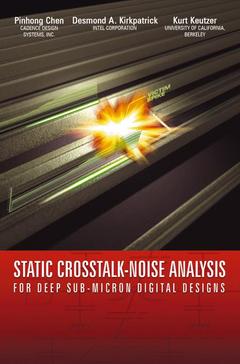Description
Static Crosstalk-Noise Analysis, 2004
For Deep Sub-Micron Digital Designs
Authors: Pinhong Chen , Kirkpatrick Desmond A., Keutzer Kurt
Language: English
Subject for Static Crosstalk-Noise Analysis:
Keywords
CMOS; Olson; Signal; algorithms; complexity; construction; digital design; interconnect; mechanism; model; modeling; network; optimization; published; tables
Approximative price 105.49 €
In Print (Delivery period: 15 days).
Add to cartPublication date: 05-2013
113 p. · 15.5x23.5 cm · Paperback
Approximative price 105.49 €
Subject to availability at the publisher.
Add to cartPublication date: 06-2004
113 p. · 15.5x23.5 cm · Hardback
Description
/li>Contents
/li>
This book describes accurate but conservative methods for computing delay variation due to coupling. Furthermore, most of these methods are computationally efficient enough to be employed in a static timing analysis tool for complex integrated digital circuits. To achieve accuracy, a more accurate computation of the Miller factor is derived. To achieve both computational efficiency and accuracy, a variety of mechanisms for pruning the search space are detailed, including:
-Spatial pruning - reducing aggressors to those in physical proximity,
-Electrical pruning - reducing aggressors by electrical strength,
-Temporal pruning - reducing aggressors using timing windows,
-Functional pruning - reducing aggressors by Boolean functional analysis.
These books may interest you

IC Interconnect Analysis 158.24 €



